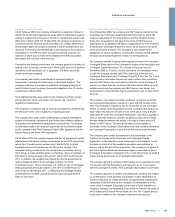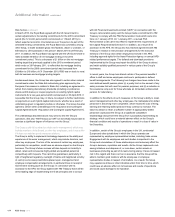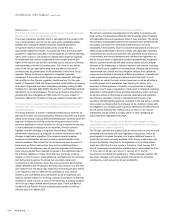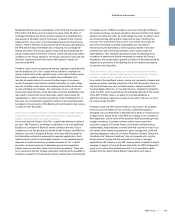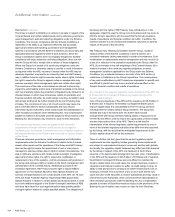RBS 2010 Annual Report Download - page 412
Download and view the complete annual report
Please find page 412 of the 2010 RBS annual report below. You can navigate through the pages in the report by either clicking on the pages listed below, or by using the keyword search tool below to find specific information within the annual report.Risk factors continued
The credit quality of the Group’s borrowers and counterparties is
impacted by prevailing economic and market conditions, as well as by the
legal and regulatory landscape in their respective markets, and if there is
afurther deterioration in economic and market conditions in one or more
markets in which the Group operates or there are changes to the legal or
regulatory landscapes in such markets, this could worsen the credit
quality of the Group’s borrowers and counterparties and also impact the
Group's ability to enforce contractual security rights.
In the United States during the last year there has been disruption in the
ability of certain financial institutions to complete foreclosure proceedings
in a timely manner (or at all), including as a result of interventions by
certain states and local governments. This disruption has lengthened the
time to complete foreclosures, increased the backlog of repossessed
properties and, in certain cases, has resulted in the invalidation of
purported foreclosures. In addition, a number of other financial institutions
have experienced increased repurchase demands in respect of US
mortgage loans or other related securities originated and sold. However,
the Group has not experienced a significant volume of repurchase
demands in respect of similar loans or related securities it originated or
sold and has not ceased any of its US foreclosure activities.
The trends and risks affecting borrower credit quality have caused, and in
the future may cause, the Group to experience further and accelerated
impairment charges, increased repurchase demands, higher costs,
additional write-downs and losses for the Group, and may result in a loss
of value in the Securities.
The actual or perceived failure or worsening credit of the Group’s
counterparties has adversely affected and could continue to adversely
affect the Group.
The Group’s ability to engage in routine funding transactions has been
and will continue to be adversely affected by the actual or perceived
failure or worsening credit of its counterparties, including other financial
institutions and corporate borrowers. The Group has exposure to many
different industries and counterparties and routinely executes
transactions with counterparties in the financial industry, including
brokers and dealers, commercial banks, investment banks, mutual and
hedge funds and other institutional clients. As a result, defaults by, or
even the perceived creditworthiness of or concerns about, one or more
corporate borrowers, financial institutions, sovereign counterparties or the
financial services industry generally, have led to market-wide liquidity
problems, losses and defaults and could lead to further losses being
incurred by the Group or by other institutions. Many of these transactions
expose the Group to credit risk in the event of default of the Group’s
counterparty or client and the Group does have significant exposures to
certain individual counterparties (including counterparties in certain
weakened sectors and geographic markets, particularly the United States
and Europe). In addition, the Group’s credit risk is exacerbated when the
collateral it holds cannot be realised or is liquidated at prices not sufficient
to recover the full amount of the loan or derivative exposure that is due to
the Group, which is most likely to occur during periods of illiquidity and
depressed asset valuations, such as those experienced in recent years.
Any such losses could have an adverse effect on the Group’s results of
operations and financial condition or result in a loss of value in the
Securities.
The Group’s earnings and financial condition have been, and its future
earnings and financial condition may continue to be, materially affected
by depressed asset valuations resulting from poor market conditions.
Financial markets continue to be subject to significant stress conditions,
where steep falls in perceived or actual asset values have been
accompanied by a severe reduction in market liquidity, as exemplified by
recent events affecting asset-backed collateralised debt obligations,
residential mortgage-backed securities and the leveraged loan market. In
dislocated markets, hedging and other risk management strategies have
proven not to be as effective as they are in normal market conditions due
in part to the decreasing credit quality of hedge counterparties, including
monoline and other insurance companies and credit derivative product
companies. Severe market events have resulted in the Group recording
large write-downs on its credit market exposures in recent years. Any
deterioration in economic and financial market conditions could lead to
further impairment charges and write-downs. Moreover, market volatility
and illiquidity (and the assumptions, judgements and estimates in relation
to such matters that may change over time and may ultimately not turn
out to be accurate) make it difficult to value certain of the Group’s
exposures. Valuations in future periods, reflecting, among other things,
then-prevailing market conditions and changes in the credit ratings of
certain of the Group’s assets, may result in significant changes in the fair
values of the Group’s exposures, even in respect of exposures, such as
credit market exposures, for which the Group has previously recorded
write-downs. In addition, the value ultimately realised by the Group may
be materially different from the current or estimated fair value. Any of
these factors could require the Group to recognise further significant
write-downs in addition to those already recorded or realised or realise
increased impairment charges, which may have a material adverse effect
on its financial condition and its results of operations or result in a loss of
value in the Securities.
Further information about the write-downs which the Group has incurred
and the assets it has reclassified can be found in the Risk and balance
sheet management section of the Business review.
The value or effectiveness of any credit protection that the Group has
purchased from monoline and other insurers and other market
counterparties (including credit derivative product companies) depends
on the value of the underlying assets and the financial condition of the
insurers and such counterparties.
The Group has credit exposure arising from over-the-counter derivative
contracts, mainly credit default swaps (“CDSs”), which are carried at fair
value. The fair value of these CDSs, as well as the Group’s exposure to
the risk of default by the underlying counterparties, depends on the
valuation and the perceived credit risk of the instrument against which
protection has been bought. Since 2007, monoline and other insurers and
other market counterparties (including credit derivative product
companies) have been adversely affected by their exposure to residential
mortgage linked and corporate credit products, whether synthetic or
otherwise, and their actual and perceived creditworthiness has
deteriorated rapidly, which may continue. If the financial condition of
these counterparties or their actual or perceived creditworthiness
deteriorates further, the Group may record further credit valuation
adjustments on the credit protection bought from these counterparties
under the CDSs in addition to those already recorded and such
adjustments may have a material adverse impact on the Group’s financial
condition and results of operations.
RBS Group 2010410
Additional information continued



